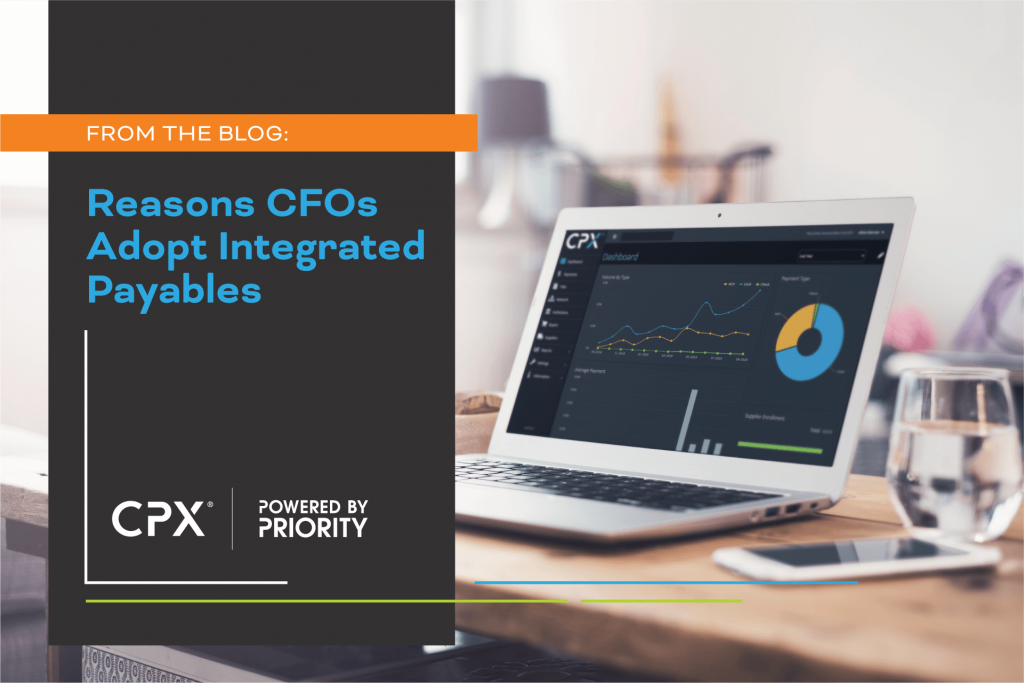
Business financial leaders often get bogged down with overseeing the accounts payable operations and logistics—such as managing cash flow and ensuring suppliers get paid in a timely, efficient manner. Today’s integrated payables solutions eliminate manual processes to streamline a company’s AP workflows. As a result, it allows financial leaders the time needed to focus on the more strategic and revenue-generating aspects of their role.
Here are five key reasons financial leaders are adopting integrated payables:
1. Implementing a modern end-to-end integrated payables solution with minimal to no upfront investment required.
An integrated payables solution is essentially a one-stop solution with a platform that facilitates multiple forms of B2B supplier payments, including ACH electronic transfer, wire transfer, paper checks and virtual credit cards. The IP provider receives a single instruction file from the company with the list of suppliers that need to be paid and its activation team contacts each one to arrange the optimal payment method for that supplier. The team can steer suppliers toward your company’s preferred payment methods by allowing them to get paid faster if they choose a virtual card payment.
This means each supplier has the choice and flexibility to be paid in a way that meets its needs, but your company doesn’t need to spend its valuable resources negotiating these terms and integrating all the various payment technologies. It’s all provided through a cloud-based online portal. Furthermore, open solutions enable easy integration with your existing bank and processor.
2. Gaining efficiency with automation streamlining cumbersome payment processes.
Today’s smartest financial leaders are all about efficiency and streamlining processes. They look to use automation to reduce time-consuming manual AP tasks—such as negotiating payment terms with each supplier and processing paper checks—and in turn, lowering the odds of costly errors.
Moreover, an IP platform can seamlessly integrate with your other tools, such as your enterprise resource planning (ERP) system or accounting software, allowing for information sharing and reducing the need to re-enter payment data in multiple places. For example, for a company with dozens of suppliers, this integration could offer huge time savings while providing the opportunity for greater, real-time data visibility.
In fact, according to a report in Business Insider Intelligence, 44% of businesses surveyed were looking to add automation to their payables processes in order to capitalize on the efficiency and cost-cutting it provides, while also reducing fraud and increasing access to payment data.
3. Reducing costs to make a positive impact to the bottom line.
Processing paper checks is expensive, even though many companies still do it. But the potential cost savings is a big motivating factor for financial leaders who make the switch to an IP solution.
According to a recent Levvel study, processing a single invoice without automation costs an average of $15, but automation can reduce that cost by 85%. In the case of a company that processes hundreds of checks a month, those realized savings positively impact its bottom line.
The various automation and streamlining provided by integrated payables means your AP staff will spend far less time on payment processing—which ultimately allows your staff to focus on higher-value activities and potentially reduces overhead costs.
4. Increasing visibility into costs and spending.
Beyond facilitating supplier payments, today’s best IP solutions give a company’s financial leaders a clear view of their spending and payments data—which is critical for making better decisions.
One timely example: Construction firm leaders today must pay extra close attention to materials costs—as materials prices have fluctuated significantly in recent years. An IP solution allows them to easily track how their payments on specific materials or to specific suppliers have changed over time. This allows them to provide more accurate cost estimates to their clients and not underbid on jobs.
But regardless of your industry, an IP platform’s dashboard lets you view your spending and payments data in multiple ways and run the reports you need—real-time from anywhere and anyhow.
5. Boosting top line revenue.
As IP solutions provide the data to help financial leaders be smarter in their decision making, it can also help them identify new revenue-generating opportunities. By knowing how much you’re spending on various expenses, you might be able to now spot financial opportunities. For example, a company may see that a product it sells costs less to manufacture now than it did previously—meaning there’s an opportunity to generate a higher profit margin on that product or sell more of it.
There also can be opportunities for the company to save and earn money by shifting to electronic payments. For example, companies can use the platform to pay their suppliers faster by tapping into early-payment discounts. Moreover, when companies pay their suppliers electronically via virtual cards, they can earn rebates—essentially getting a cut of the processing fees charged by those cards.
An ideal modern B2B digital payment solution
In essence, an integrated payables solution like Priority’s CPX® platform can simply and affordably help financial leaders bring today’s AP operations into the modern world—by providing suppliers with a range of electronic payment options. At the same time, it offers companies many other valuable benefits, such as allowing them to streamline their payments processes, reduce costs and glean useful insights from their spending and payments data.



